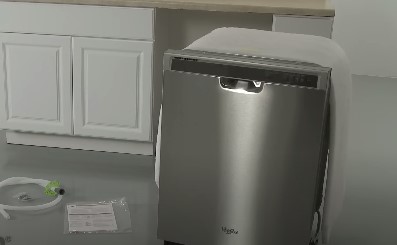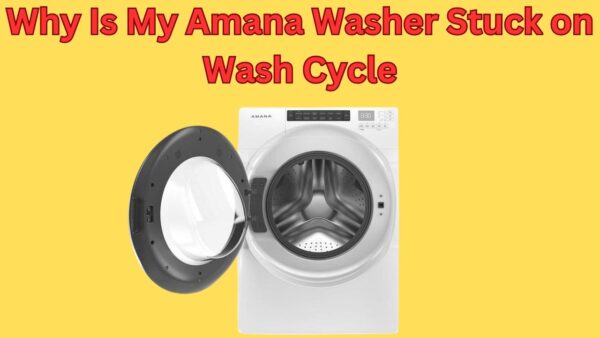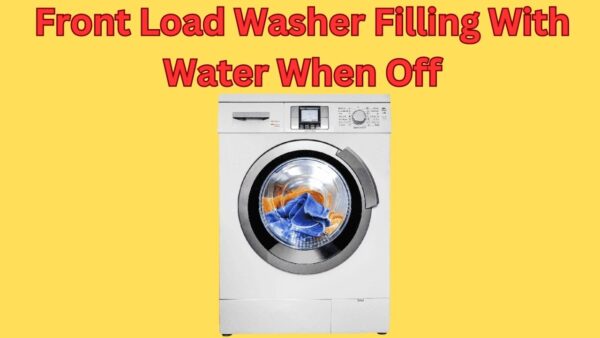Hi dear visitor welcome to our blog.
If you are facing this problem the Whirlpool dishwasher fills but does not spray.
So Don’t worry in this guide we provide you with 12 common reasons for this problem with unique solutions.
Whirlpool dishwasher fills but does not spray

1. Clogged Spray Arm
Cause
A common cause for a Whirlpool dishwasher not spraying water is a clogged spray arm. Over time, small particles of leftover food can get trapped in the tiny holes in the washer arm.
These obstructions prevent water from spraying out with the necessary force to clean dishes efficiently.
Key point: Regular maintenance and checking for obstructions in the spray arm can prevent this issue.
Solution
The solution to a clogged spray arm is straightforward – it needs to be cleaned. To do this, first, remove the spray arm from the dishwasher. It can usually be unscrewed easily.
Next, rinse it under tap water to dislodge any loose particles. For stubborn clogs, use a thin piece of wire or a toothpick to gently remove the debris.
Once cleaned, screw the spray arm back into place.
Key point: Regularly cleaning your dishwasher’s spray arm can ensure its longevity and efficiency.
2. Faulty Water Inlet Valve
Cause
The water inlet valve is responsible for allowing water to enter the dishwasher.
If it’s malfunctioning, it could prevent the water from reaching the spray arms, thus causing the dishwasher to fill but not spray.
Common signs of a faulty water inlet valve include unclean dishes after a wash cycle, unusually low water levels, or noticeable leaks under the dishwasher.
Solution
The most effective solution for a faulty water inlet valve is to replace it. Turn off the water supply and disconnect the power to the dishwasher before starting the replacement process.
Remove the lower kickplate, locate the water inlet valve, and disconnect the wiring and tubing. Replace the faulty valve with a new one and reconnect everything.
Remember, it’s always safer and advisable to hire a professional if you’re not comfortable performing these steps yourself.
3. Malfunctioning Float Switch
Cause
A dishwasher float switch regulates water intake. It is designed to prevent overflow by signaling the dishwasher to stop filling with water when the desired level is reached.
A malfunctioning float switch could fail to send this signal, resulting in a dishwasher that fills with water but does not spray. This issue could be due to a stuck float or a faulty switch.
Important Note: Always unplug the dishwasher before attempting any repairs.
Solution
To fix the issue, first examine the dishwasher float to see if it’s stuck or obstructed.
If it is, remove the obstruction or clean the area to allow the float to move freely. If the float is not the problem, consider replacing the float switch.
This task may require professional assistance if you’re not familiar with dishwasher repairs.
Remember, it’s often more cost-effective and safer to hire a professional than to risk causing additional damage or potential injury by attempting self-repairs.
4. Damaged Circulation Pump
Cause
The circulation pump is a vital component of your Whirlpool dishwasher, responsible for spraying water and circulating it throughout the unit.
If this pump is faulty or damaged, it can result in the dishwasher filling up, but not spraying the water.
Common indicators of a damaged circulation pump include unusual noises during the wash cycle or dishes not being cleaned properly.
Solution
To resolve this issue, the circulation pump must be inspected and then replaced if necessary. Ensure the dishwasher is unplugged before you proceed to avoid any electrical accidents.
You can access the circulation pump usually at the bottom of the dishwasher. If you’re not comfortable doing this yourself, consider hiring a professional repair service.
Remember, while replacing the circulation pump can be a costlier repair, it’s essential for the proper functioning of your Whirlpool dishwasher.
5. Defective Pressure Switch
Cause
The pressure switch, also known as the water level switch, is responsible for controlling the amount of water that enters the dishwasher.
If this switch is defective, the dishwasher may not fill completely or may overfill. This could cause the dishwasher to not spray water properly.
Solution
In the case of a defective pressure switch, it would need to be replaced. Turn off the power to the dishwasher and remove the lower access panel to reach the pressure switch.
Make sure to disconnect the wires carefully before removing the old switch and installing the new one.
Always refer to your dishwasher’s manual or consult a professional to ensure you are performing this task safely and correctly.
Replacing a faulty pressure switch should restore normal water spray in your dishwasher.
6. Blocked Pump Filter
Cause
When the Whirlpool dishwasher fills but does not spray, one common cause could be a blocked pump filter.
Over time, tiny bits of food particles or other debris can get trapped in the pump filter, hindering the spray arms from functioning properly.
This blockage prevents the water from being distributed evenly and forcefully, compromising the efficiency of the cleaning cycle.
Notably, a blocked pump filter not only restricts the water flow but also potentially damages the dishwasher motor in the long run.
Solution
Clearing a blocked pump filter is a relatively straightforward task. Start by disconnecting the dishwasher from the power source for safety reasons.
Next, you need to locate the pump filter, generally situated at the bottom of the dishwasher. Detach the filter and thoroughly wash it under running water to remove any blockages.
Make sure to scrub gently using a soft-bristled brush to dislodge any stubborn particles. Once the filter is clean, reattach it and restore the power.
Remember to regularly clean the pump filter to prevent future blockages and ensure optimum performance of your dishwasher.
7. Impaired Motor
Cause
An impaired motor could be the culprit if your Whirlpool dishwasher fills with water but does not spray it.
The motor is the heart of the spray system, driving the pump that pushes water into the spray arms.
If the motor is not functioning properly, the water will not reach the necessary pressure to be sprayed, leaving your dishes uncleaned.
Solution
There are a few interventions you can take to address a faulty motor. Firstly, you can try resetting the dishwasher.
Turn off the dishwasher and disconnect it from the power source for about fifteen minutes, then reconnect it to see if the motor starts working.
If this doesn’t resolve the issue, it may be necessary to replace the motor. It’s recommended to hire a professional for this task to ensure it’s done correctly and safely.
8. Incorrect Timer Settings
Cause
If your Whirlpool dishwasher fills but doesn’t spray, the problem could be due to incorrect timer settings.
The timer controls the sequence of functions in your dishwasher and if it’s not set correctly, it may fill up with water but not cycle on to the spray stage.
Remember, the timer is like the brain of the dishwasher. Incorrect settings can disrupt the normal operation cycle of the dishwasher.
Solution
The solution lies in checking and adjusting the timer settings. Refer to your dishwasher’s user manual for specific instructions on how to reset the timer.
If the problem persists after adjusting the timer, it may indicate a malfunctioning timer that needs replacement.
Checking and adjusting the timer settings should be the first step in diagnosing spray problems. If all else fails, consider seeking help from a professional.
9. Damaged Heating Element
Cause
The heating element in a dishwasher is responsible for heating the water used during the wash cycle.
If the heating element is damaged, it may render the dishwasher incapable of producing the hot water necessary to effectively spray and clean dishes.
The most common signs of a damaged heating element include visibly cracked or broken coils, a lack of hot water, and dishes coming out dirty after a complete wash cycle.
Solution
The most effective solution to a damaged heating element is to replace it. Before proceeding, ensure the dishwasher is unplugged and the water supply is turned off to avoid any accidents.
You can typically find the heating element at the bottom of the dishwasher.
After removing the lower rack, unscrew the element from the tub, disconnect the wires, and replace it with a new one. Always refer to the user manual or seek professional help if unsure.
10. Faulty Thermostat
Cause
A faulty thermostat in your dishwasher could result in the machine filling up but not spraying water.
The thermostat ensures that the water used by the dishwasher is heated to the ideal temperature for effective cleaning.
If the thermostat is defective, it may prevent the water from reaching the required heat, thus inhibiting the spray feature.
Key Point: The thermostat regulates the water temperature in the dishwasher. A faulty thermostat may disrupt the heating process, hindering the spray feature.
Solution
To resolve this issue, you must first confirm that the thermostat is indeed faulty.
This could be done using a multimeter to check for continuity. In the event of a faulty thermostat, replacing it with a new one often solves the problem.
Be sure to consult your dishwasher’s manual or a professional service to correctly replace the thermostat.
Key Point: Test the thermostat with a multimeter. If it is indeed faulty, replacing the thermostat should rectify the spray issue.
Always refer to your dishwasher’s manual or seek a professional’s advice when replacing parts.
11. Blocked Drain Hose
Cause
A blocked drain hose is a common reason why a Whirlpool dishwasher fills but does not spray.
Over time, food particles and other debris can accumulate in the drain hose, creating a blockage that prevents water from flowing freely.
Solution
One solution is to disconnect the hose and clean it out manually. Start by unplugging the dishwasher and locating the drain hose, typically attached to the back.
Once located, disconnect the hose and use a long-handled brush to clear out any blockage. After cleaning, reconnect the hose and run a cycle to check if the problem has been resolved.
Remember, if you’re not comfortable performing this task, consider hiring a professional to avoid causing further damage to the appliance.
12. Inadequate Water Level
Cause
A common cause of a Whirlpool dishwasher not spraying water is an inadequate water level.
When there’s insufficient water, the dishwasher cannot generate the proper pressure to activate the spray arms.
Sometimes, this could be due to a problem with the water inlet valve, float switch, or even a kink in the water line.
Key Point: Inadequate water levels prevent the dishwasher from spraying water, and could be due to issues with the water inlet valve, float switch, or water line.
Solution
To resolve this issue, you should first ensure that the water supply to your dishwasher is turned on and that the water line is not kinked.
If these are fine, you may need to inspect the water inlet valve and the float switch, which might require professional assistance. Regular maintenance of these components would prevent such issues in the future.
Remember: Check the water supply, the water line, and potentially the water inlet valve and the float switch. Regular maintenance helps prevent these problems.
Conclusion
If your Whirlpool dishwasher fills up but doesn’t spray, the issue could be due to a number of reasons.
The water pump belt might be worn out, the spray arm might be clogged, or there could be an issue with the motor.
Each of these issues requires different troubleshooting steps. By identifying the exact cause of the problem, you can take appropriate steps to fix it, which may involve cleaning, replacing parts, or calling a professional repair service.
Remember, a well-functioning dishwasher not only ensures clean dishes but also saves you time and effort, so it’s worth addressing these issues promptly.
FAQs
Q: Why is my Whirlpool dishwasher not releasing water?
A: The water may not be released due to a clogged or faulty drain pump or hose, preventing the water from draining out of the dishwasher.
Q: Why is my spray arm not turning on my Whirlpool dishwasher?
A: The spray arm might not be turning due to a blockage in the spray arm itself or a malfunction in the motor that drives it.
Q: Why does my Whirlpool dishwasher fill up but not wash?
A: This could be due to a malfunctioning motor, a worn-out water pump belt, or a clogged spray arm, all impeding water circulation required for washing.
Ge Dishwasher No Power No Lights
Samsung Dishwasher Door Won’t Open All the Way
Whirlpool Dishwasher Rinse Aid Dispenser Leaking
Bosch Dishwasher Latch Stuck in Locked Position
Bosch Dishwasher Flashing Red Light
Bosch Dishwasher Keeps Asking For Salt
Indesit Dishwasher Flashing Lights 1 and 3
Whirlpool Dishwasher Not Heating Water

Name: Joseph Title: Owner and Founder Website: myappliancegeek.com
Biographical Info:
Joseph, the creative mind and founder behind myappliancegeek.com is a distinguished expert in the field of home appliances and technology.
Education: Joseph holds a prestigious degree in Appliance Engineering from a renowned institution in the United States, [Stanford University], where he gained a profound understanding of appliance design, mechanics, and technology.
Professional Experience: Joseph’s professional journey spans over [18 ] years in the home appliance industry. His extensive experience includes working with industry-leading appliance manufacturers, prominent retailers, and appliance repair services.
Entrepreneurship: In [2000], Joseph founded myappliancegeek.com, a platform dedicated to providing comprehensive information, advice, and solutions for those seeking guidance in the world of appliances.
Passion for Appliances: Joseph’s unwavering passion for home appliances stems from his belief in their pivotal role in improving our quality of life.
Contributions to the Industry: Joseph’s commitment to the home appliance industry is evident through his extensive writing and speaking engagements.
Community Involvement: Joseph is not only an online presence but also an active member of the community, frequently engaging in outreach programs, local workshops, and charitable initiatives.


